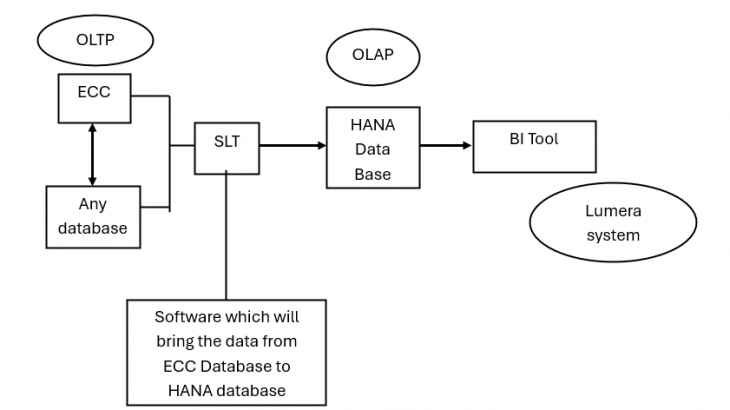SAP S/4HANA
SAP S/4HANA is the latest version of SAP. The full form of SAP S/4HANA is SAP Business Suite 4th generation ERP High Performance Analytic Appliance.
There are 3 layers that are present in SAP namely:-
- Presentation layer
- Application Layer
- Database Layer
In the 1990’s a new architecture was introduced, and it was R/3. In R/3 architecture we can observe the three layers namely presentation layer, application layer and database layer.
The speed of R/3 architecture is fast when compared with R/2 architecture. The algorithms in R/2 architecture were in the database layer whereas the algorithms in R/3 architecture are in the application layer. The database layer can be anyone like oracle, Microsoft etc…
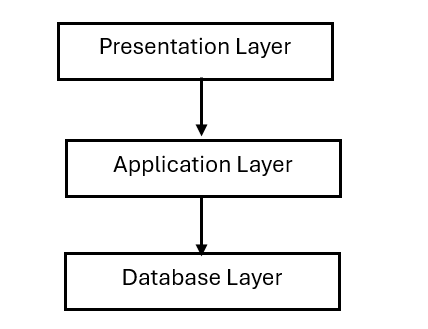
1. Presentation Layer
The presentation layer is a screen where user can interact with the system. For example we can take Monitor of a computer or laptop screen. So for SAP it is GUI –> Graphical User Interface. Here user will interact with SAP data base with the help of SAP GUI which is a software that will be installed on laptops.
2. Application Layer
This is the main advantage of SAP R/3 architecture. Here it acts as like middle wear between presentation layer and database layer. Here it will process the user input , applies business rules and execute the programs in this layer.
Here in this layer it will collects all the details or actions that are being carried out by the user and interacts with the database system and represents them on the output screen.
Dispatcher: Dispatcher will collects the request and will decide which type of request it is whether it is dialog, update, background, spool , enqueue. After getting to know about the spool request type it will also check for the work processor which is idle.
Work Processor:- After getting the request into work processor it will co-ordinate with the database management and will perform the operation or action on the database and will also gets a acknowledgement .
3. Database layer
After getting the request or command form the database management the database layer will process it and will update the request.
The below diagram is the in-depth process of how the database layer will function.
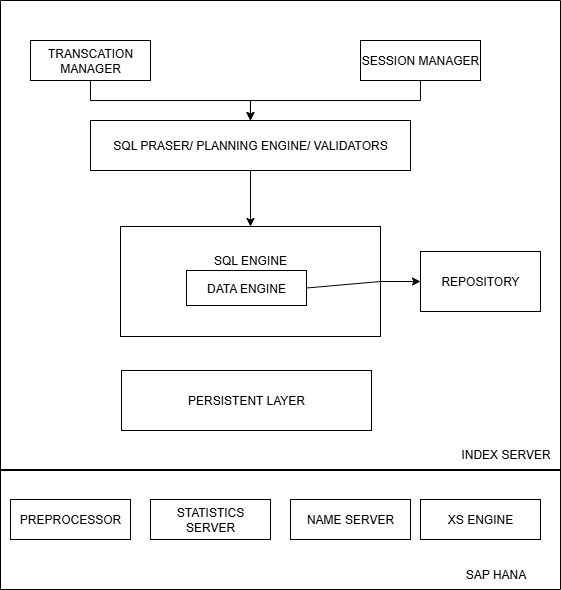
DATABASE LAYER FUNCTION FLOW:
- The request from the work processor will first enter into the session manager and the session manager will makes user to automatic behaviour and transaction isolation level.
- Once the request got established the request moves to the planning engine which analyses SQL.
- And here SQL engine will runs the machine.
- The transaction manager assigns a transaction ID and ensures that every operation follows the principle, transactions to the SQL engine and data engine.
- The data engine takes over the user request and performs it on the database.
- Index Server → Executes SQL/MDX queries, does actual processing.
- Name Server → Knows where the data lives.
- Pre-processor → Text & search.
- XS Engine → Application services.
- Persistence Layer → Save points + logs.
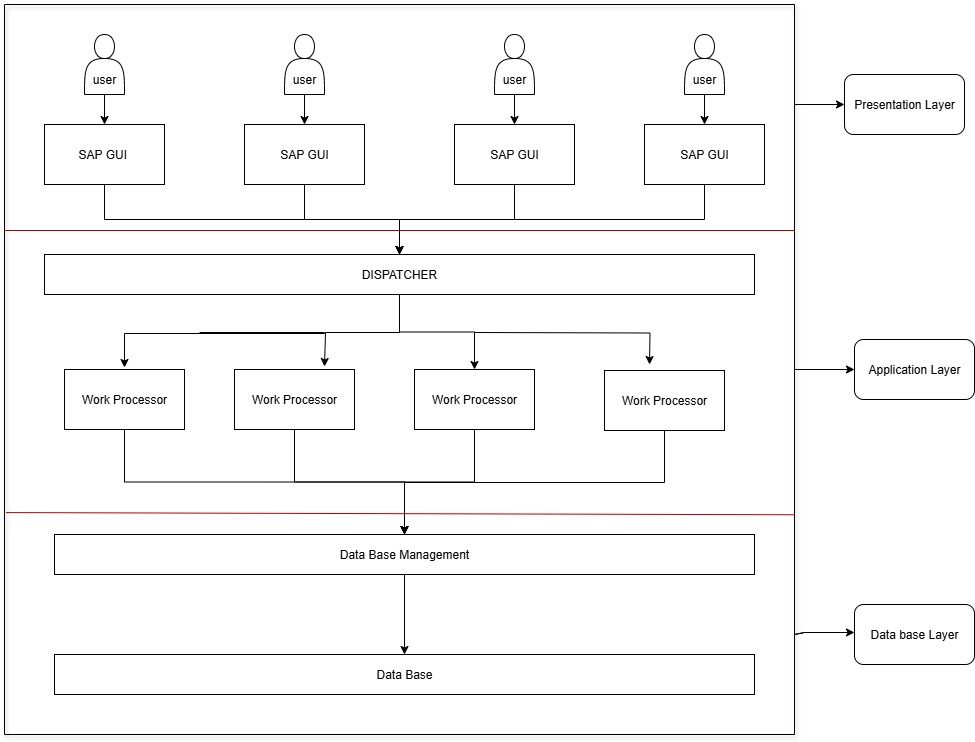
In 2015 the SAP S/4HANA has been introduced and here the database is HANA, and this is SAP’S own database. The Hana database can also be called as in-memory database.
S/4HANA is also called 4th generation SAP.
Versions of SAP S/4HANA are released in the following years: –
| VERSION | YY MM |
| 1st Version of SAP S/4HANA | 1511(2015 11th) |
| 2nd Version of SAP S/4HANA | 1610 (2016 10th) |
| 3rd Version of SAP S/4HANA | 1709(2019 9th) |
| 4th Version of SAP S/4HANA | 1809 (2018 9th) |
| 5th Version of SAP S/4HANA | 1909(2019 9th) |
| 6th Version of SAP S/4HANA | 2020 (YYYY) |
| 7th Version of SAP S/4HANA | 2021(YYYY) |
| 8th Version of SAP S/4HANA | 2022(YYYY) |
| 9th Version of SAP S/4HANA | 2023(YYYY) |
SAP S/4Hana works with Fiori NetWeaver GUI.
Advantages of sap s/4hana:
- The performance and speed have been improved due to databases.
- Embedded analytics have been embedded in sap s/4hana
- In ECC we can only perform operations, and some extract basic reports can be extracted in ECC, but not more complex reports can be extracted, when it comes to s/4Hana we can easily extract the complex reports easily.
OLTP – Online Transaction processing (ECC)
OLAP – Online Analytical Processing (BI/BW)
OLTP + OLAP + Planning – SAP S/4HANA
Planning ->
- MRP line
- PD MRP
- ATP (advanced available to promise)
- PDS (production planning and detailed scheduling)
SAP HANA: This Hana is a database which is also called an in-memory database, and this provides or is capable of analytics, data models and library for code writing.
The HANA database can be accessed through HANA STUDIO.
SAP HANA: This Hana is a database which is also called an in-memory database, and this provides or is capable of analytics, data models and library for code writing.
The HANA database can be accessed through HANA STUDIO.
SAP BW powered by HANA (BW for HANA):
SIDE CAR: For suppose you have an ECC system which is working on any database and now you want to connect it with the HANA database then there will be a middle wear SLT which is a software brings the data from table to HANA database.
- HANA live is a tool which can be used to view the analytics of data.
- Lumera system is a toll which is being used to represent or visualize the analytical data.
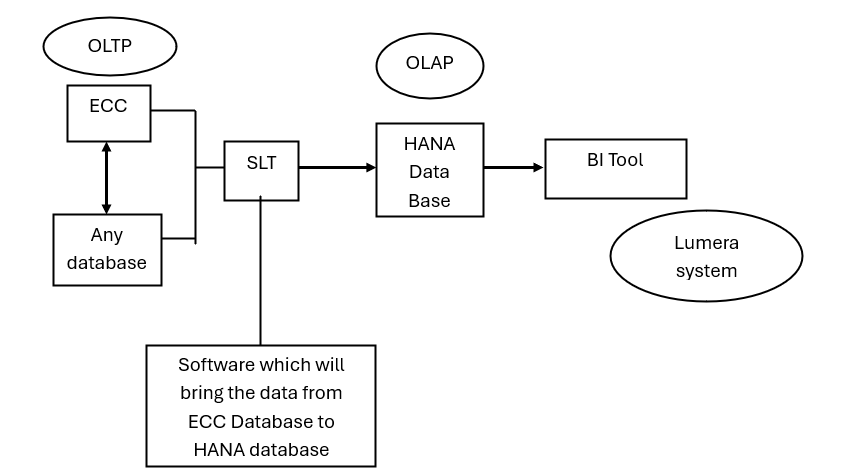
Benefits of a side car:
- Main cars are not being distributed.
- It can be implemented in 1.5 to 2 months.
Drawback:
- Data footprint increases: the data is being replicated from the production system to the side car so more space will be occupied.
- The landscape is very complex.
SAP BW POWERED BY HANA: It was introduced in 2012 and here the analytical can be obtained. The complex reports can be fetched within seconds only.
SAP BUSINESS SUIT POWERED BY SAP HANA: It was introduced in 2013 in this enhancement pack (EHP 7 or and here the system is ECC, and the database is HANA.)
OLAP + OLTP.
SAP SIMPLE FINANCE POWERED BY SAP HANA: ECC with HANA Database but the difference between this and SOH is only the fico module as they have simplified the data module for FICO and introduced Fiori apps separately for fico and ACDOCA table which is single source of truth table.
Apart from fico modules the other modules will work as they were functioning in the same manner as ECC on any other database.
S/4HANA: This was introduced in 2015 they have simplified the data model for all the modules. They have introduced MATDOC, ACDOCA table and innovations + Fiori apps for all the modules
APP_L -> Technical application for ECC.
S/4 core -> Technical application for HANA.
